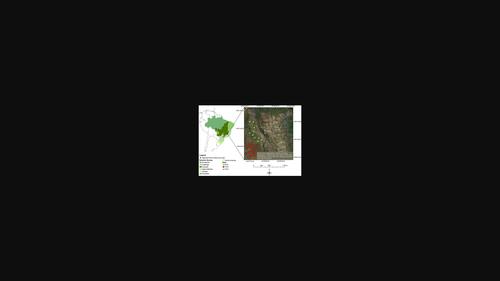当前位置:
X-MOL 学术
›
Ecol. Res.
›
论文详情
Our official English website, www.x-mol.net, welcomes your feedback! (Note: you will need to create a separate account there.)
How substrate type and elevation drive woody communities and influence species ecological strategies in the Brazilian savanna at local scale
Ecological Research ( IF 2 ) Pub Date : 2023-07-26 , DOI: 10.1111/1440-1703.12413 Patrícia Corrêa Guedes de Souza 1 , Sílvia da Luz Lima Mota 2 , Rodrigo Studart Corrêa 3 , José Roberto Rodrigues Pinto 4
Ecological Research ( IF 2 ) Pub Date : 2023-07-26 , DOI: 10.1111/1440-1703.12413 Patrícia Corrêa Guedes de Souza 1 , Sílvia da Luz Lima Mota 2 , Rodrigo Studart Corrêa 3 , José Roberto Rodrigues Pinto 4
Affiliation

|
Environmental heterogeneity can influence the formation of different vegetation types, even at small spatial scales. However, little is known about the factors that drive communities at local scales and species' mechanisms to adapt to different environments. Here, we investigated the influence of local environmental conditions and spatiality on the floristic variation of woody vegetation and ecological strategies of shrub-tree species in the Brazilian savanna. We sampled adjacent sites in three substrate types—deep soil at high altitude (in Red Oxisol, with vegetation locally called Typical Cerrado—TCRO), deep soil, sandy and at low elevation (Typical Cerrado in Entisol Quartzipsamment—TCEQ), and shallow soil with rocky outcrops at high elevation (in Entisol Lithic, with vegetation known locally as Rupestrian Cerrado—RCEL). At each environment, we inventoried the vegetation, analyzed the physical–chemical soil properties, and recorded the elevation and geographic coordinates. For the most representative species of each site and the most common one among the environments, we evaluated the functional attributes (leaf nutrient concentration, specific leaf area, and maximum population heights). We showed that substrate type and elevation explain most of the floristic variation at the local scale and that the low nutritional demand constitutes the main strategy used by the species in RCEL, while in TCEQ and TCRO, species are more efficient in resource acquisition. Our results revealed that local ecological factors and processes drive species distribution. Therefore, variations in vegetation, even at the local scale must be considered to conserve biodiversity effectively.
中文翻译:

基质类型和海拔如何在局部范围内驱动巴西稀树草原的木本群落并影响物种生态策略
即使在小空间尺度上,环境异质性也会影响不同植被类型的形成。然而,人们对推动当地规模的群落的因素以及物种适应不同环境的机制知之甚少。在这里,我们研究了当地环境条件和空间对巴西稀树草原木本植被植物区系变异和灌木树种生态策略的影响。我们对邻近地点的三种基质类型进行了采样:高海拔深层土壤(Red Oxisol,植被当地称为典型塞拉多 - TCRO)、低海拔深层土壤、沙质土壤(Entisol Quartzipsamment 中典型塞拉多 - TCEQ)和浅土高海拔处有岩石露头(恩蒂索尔岩质,植被当地称为 Rupestrian Cerrado - RCEL)。在每个环境中,我们都清点了植被,分析了土壤的物理化学性质,并记录了海拔和地理坐标。对于每个地点最具代表性的物种和环境中最常见的物种,我们评估了功能属性(叶子养分浓度、比叶面积和最大种群高度)。我们表明,基质类型和海拔解释了局部范围内的大部分植物区系变化,并且低营养需求构成了 RCEL 中物种使用的主要策略,而在 TCEQ 和 TCRO 中,物种在资源获取方面更有效。我们的结果表明,当地的生态因素和过程驱动物种分布。因此,即使在局部范围内,也必须考虑植被的变化,以有效保护生物多样性。
更新日期:2023-07-26
中文翻译:

基质类型和海拔如何在局部范围内驱动巴西稀树草原的木本群落并影响物种生态策略
即使在小空间尺度上,环境异质性也会影响不同植被类型的形成。然而,人们对推动当地规模的群落的因素以及物种适应不同环境的机制知之甚少。在这里,我们研究了当地环境条件和空间对巴西稀树草原木本植被植物区系变异和灌木树种生态策略的影响。我们对邻近地点的三种基质类型进行了采样:高海拔深层土壤(Red Oxisol,植被当地称为典型塞拉多 - TCRO)、低海拔深层土壤、沙质土壤(Entisol Quartzipsamment 中典型塞拉多 - TCEQ)和浅土高海拔处有岩石露头(恩蒂索尔岩质,植被当地称为 Rupestrian Cerrado - RCEL)。在每个环境中,我们都清点了植被,分析了土壤的物理化学性质,并记录了海拔和地理坐标。对于每个地点最具代表性的物种和环境中最常见的物种,我们评估了功能属性(叶子养分浓度、比叶面积和最大种群高度)。我们表明,基质类型和海拔解释了局部范围内的大部分植物区系变化,并且低营养需求构成了 RCEL 中物种使用的主要策略,而在 TCEQ 和 TCRO 中,物种在资源获取方面更有效。我们的结果表明,当地的生态因素和过程驱动物种分布。因此,即使在局部范围内,也必须考虑植被的变化,以有效保护生物多样性。



























 京公网安备 11010802027423号
京公网安备 11010802027423号